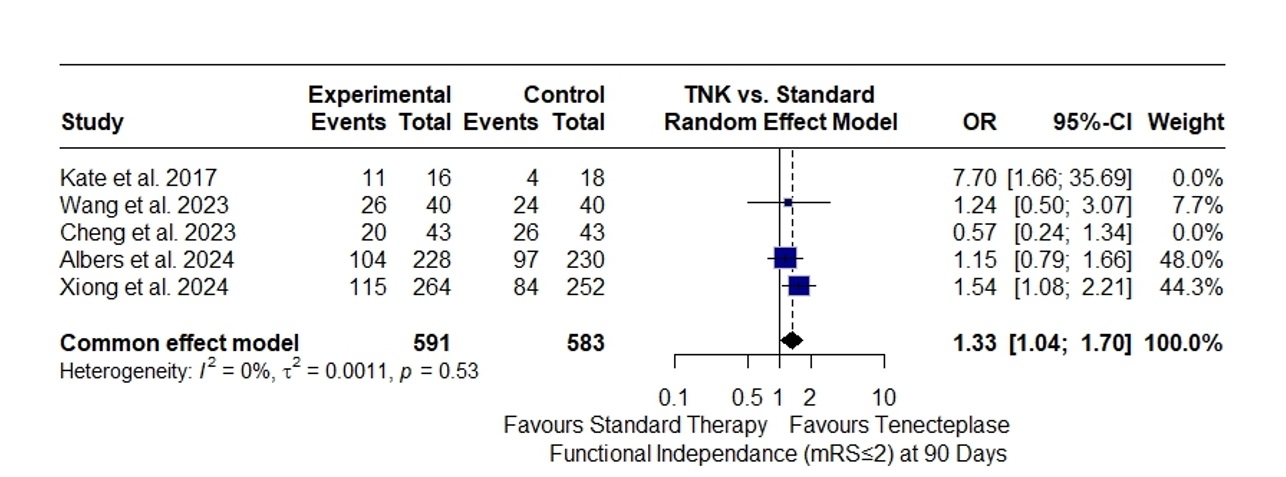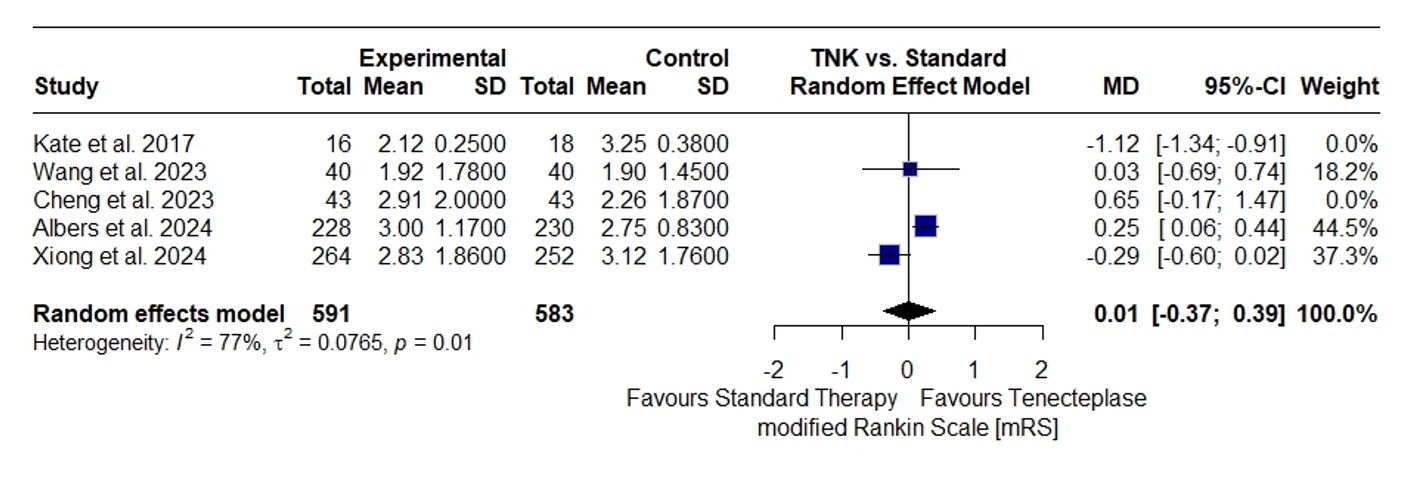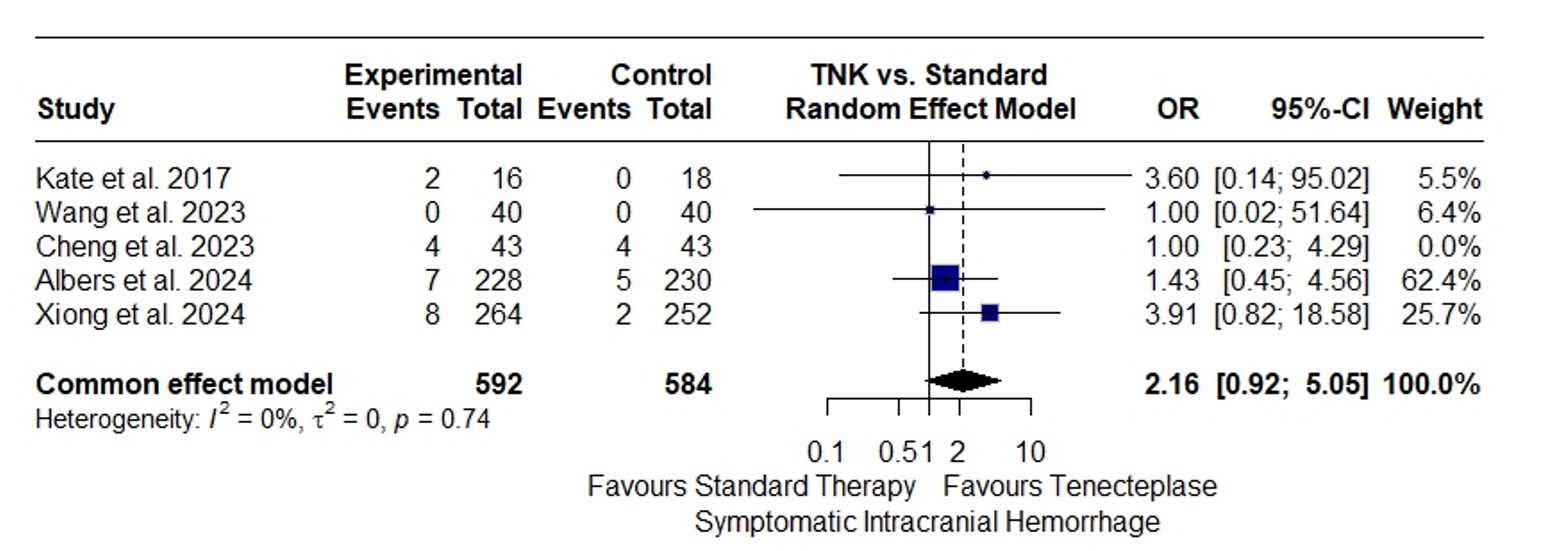Final ID: 58
Tenecteplase Beyond 4.5 Hours in Acute Ischemic Stroke: A Systematic Review and Meta-analysis of Clinical Trials
Abstract Body:
Background: Acute ischemic stroke (AIS) is a leading cause of disability worldwide. While intravenous thrombolysis is recommended within 4.5 hours of symptom onset, many patients present beyond this window. Tenecteplase (TNK) has shown to be non-inferior to tissue plasminogen activator (tPA) in early treatment window. However, its efficacy and safety in the extended 4.5 to 24-hour window remain unclear.
Methods: We conducted a systematic review and meta-analysis of published clinical trials investigating TNK administration in AIS patients between 4.5 to 24 hours of symptom onset. PubMed, Cochrane Library, Google Scholar, and ClinicalTrials.gov were searched from inception through June 23rd, 2024. Inclusion criteria were: (1) clinical trials, (2) published in English, (3) full-text available, and (4) TNK administration in AIS or transient ischemic attack patients within 4.5-24 hours of onset. Primary outcomes assessed were functional independence at 90 days (defined as a modified Rankin Scale [mRS] score of 0-2) and ordinal shift in the mRS. Safety outcomes included symptomatic intracranial hemorrhage (sICH). Random-effects models were used to calculate pooled odds ratios (OR) with 95% confidence intervals (CI).
Results: Five clinical trials met inclusion criteria with a total of 1,197 patients (599 TNK, 598 best medical therapy). Mean age was 71 years, with 61.7% males and a median baseline NIHSS of 10. Studies varied in imaging selection criteria, using either MRI DWI/FLAIR mismatch or CTP imaging with different perfusion cut-off values. Additionally, the proportion of patients receiving EVT post-randomization varied among studies. TNK treatment was associated with increased functional independence at 90 days (OR 1.33, 95% CI 1.04-1.70, p=0.02), but no significant difference in overall mRS (standardized mean difference: 0.01, 95% CI -0.37 to 0.39, p=0.969). A trend towards increased sICH with TNK was observed, though not statistically significant (OR 2.16, 95% CI 0.96-5.05, p=0.06).
Conclusion: This meta-analysis suggests that TNK might be safe and effective for AIS patients in the 4.5 to 24-hour time window, potentially offering improved functional outcomes without significant increase in sICH. Future research should focus on conducting large, multicenter randomized controlled trials with refined patient selection criteria and standardized imaging protocols, to more precisely access the risk-benefit profile of TNK in extended time window.
Background: Acute ischemic stroke (AIS) is a leading cause of disability worldwide. While intravenous thrombolysis is recommended within 4.5 hours of symptom onset, many patients present beyond this window. Tenecteplase (TNK) has shown to be non-inferior to tissue plasminogen activator (tPA) in early treatment window. However, its efficacy and safety in the extended 4.5 to 24-hour window remain unclear.
Methods: We conducted a systematic review and meta-analysis of published clinical trials investigating TNK administration in AIS patients between 4.5 to 24 hours of symptom onset. PubMed, Cochrane Library, Google Scholar, and ClinicalTrials.gov were searched from inception through June 23rd, 2024. Inclusion criteria were: (1) clinical trials, (2) published in English, (3) full-text available, and (4) TNK administration in AIS or transient ischemic attack patients within 4.5-24 hours of onset. Primary outcomes assessed were functional independence at 90 days (defined as a modified Rankin Scale [mRS] score of 0-2) and ordinal shift in the mRS. Safety outcomes included symptomatic intracranial hemorrhage (sICH). Random-effects models were used to calculate pooled odds ratios (OR) with 95% confidence intervals (CI).
Results: Five clinical trials met inclusion criteria with a total of 1,197 patients (599 TNK, 598 best medical therapy). Mean age was 71 years, with 61.7% males and a median baseline NIHSS of 10. Studies varied in imaging selection criteria, using either MRI DWI/FLAIR mismatch or CTP imaging with different perfusion cut-off values. Additionally, the proportion of patients receiving EVT post-randomization varied among studies. TNK treatment was associated with increased functional independence at 90 days (OR 1.33, 95% CI 1.04-1.70, p=0.02), but no significant difference in overall mRS (standardized mean difference: 0.01, 95% CI -0.37 to 0.39, p=0.969). A trend towards increased sICH with TNK was observed, though not statistically significant (OR 2.16, 95% CI 0.96-5.05, p=0.06).
Conclusion: This meta-analysis suggests that TNK might be safe and effective for AIS patients in the 4.5 to 24-hour time window, potentially offering improved functional outcomes without significant increase in sICH. Future research should focus on conducting large, multicenter randomized controlled trials with refined patient selection criteria and standardized imaging protocols, to more precisely access the risk-benefit profile of TNK in extended time window.
More abstracts on this topic:
Atorvastatin Treatment and Rebleeding in Cerebral Cavernous Malformations:
A Randomized, Placebo-Controlled, Double-Blinded Clinical Trial
A Randomized, Placebo-Controlled, Double-Blinded Clinical Trial
Awad Issam
Automated Identification of Stroke Thrombolysis Contraindications from Synthetic Clinical NotesChen Bing Yu, Hussain Muhammad, Gonzalez Marco, Antaki Fares, Delora Adam, Aube Eric, Albahra Samer, Robertson Scott, Uchino Ken, Russman Andrew
Readers' Comments
We encourage you to enter the discussion by posting your comments and questions below.
Presenters will be notified of your post so that they can respond as appropriate.
This discussion platform is provided to foster engagement, and simulate conversation and knowledge sharing.
You have to be authorized to post a comment. Please, Login or Signup.
Rate this abstract
(Maximum characters: 500)



